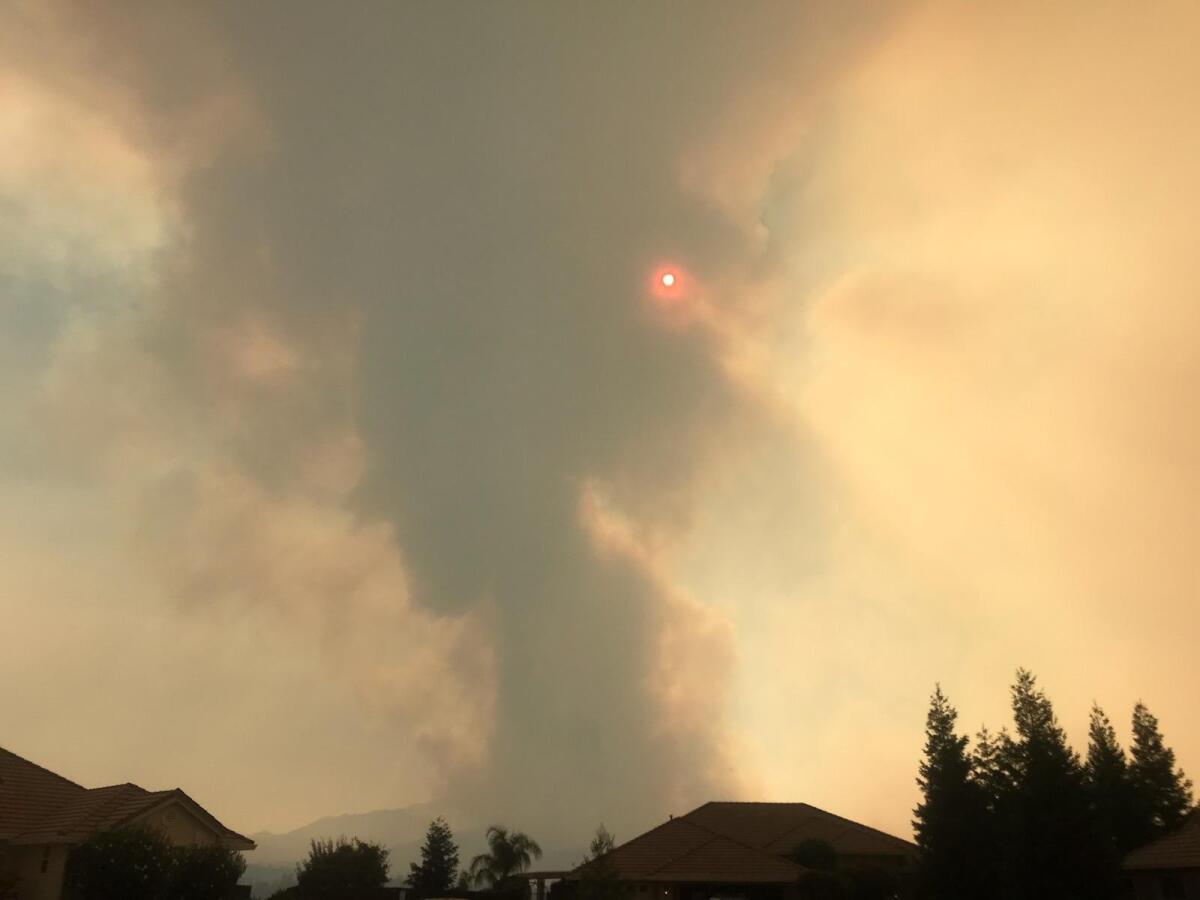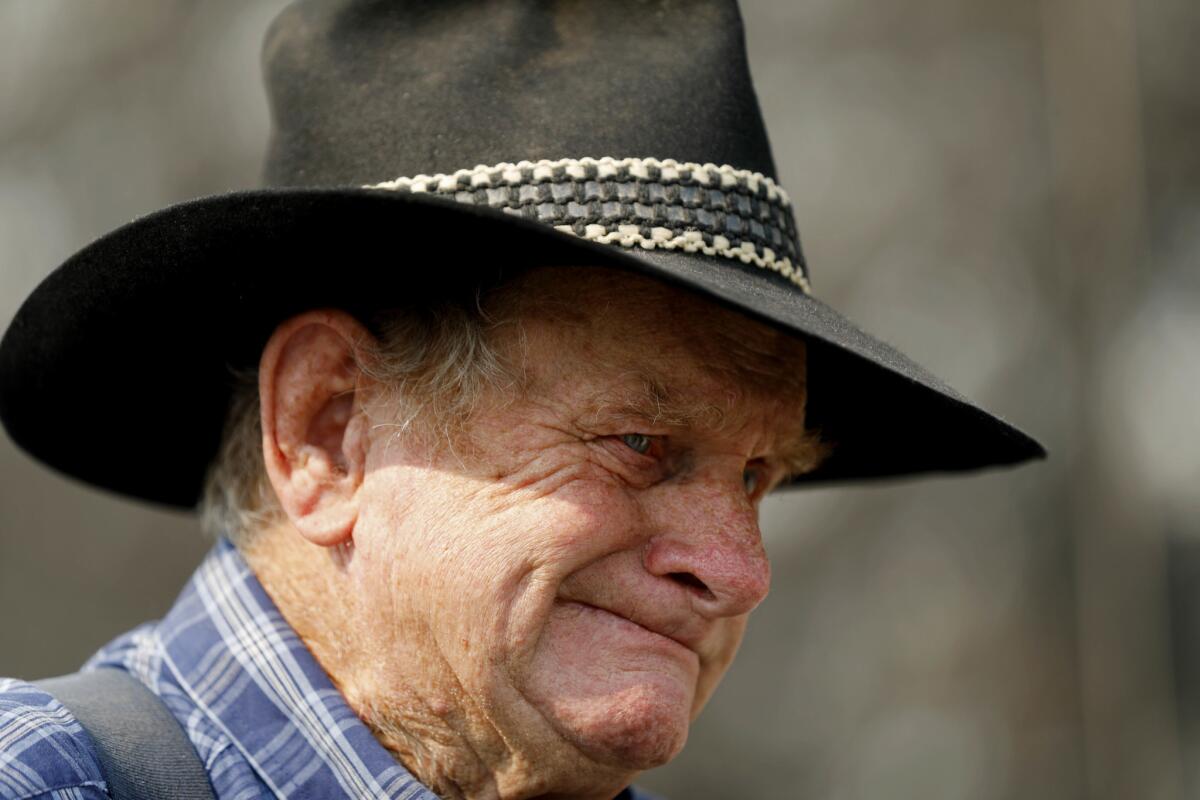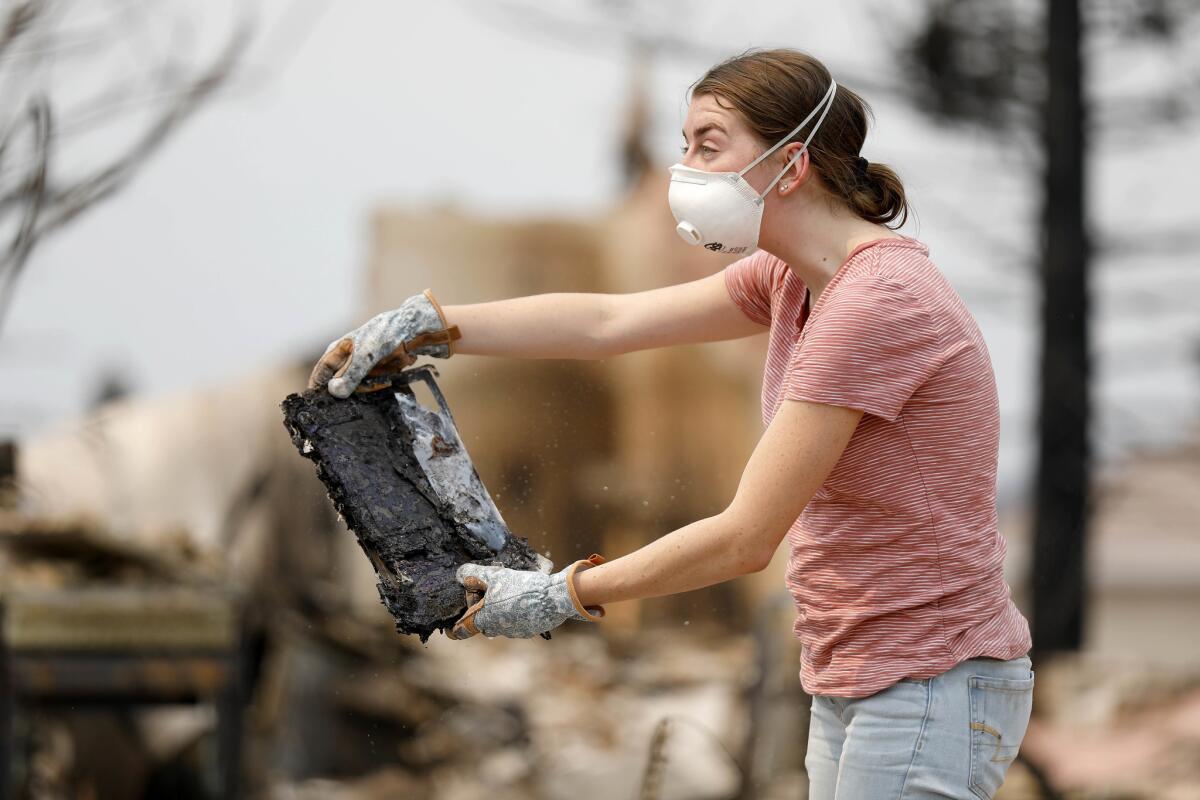Without warning: Redding fire moved faster than evacuation orders, leaving a deadly toll

- Share via
The Carr fire swept into the edge of this city without mercy, leveling two neighborhoods on either side of the Sacramento River.
On the western side of the river, authorities began issuing warnings door to door in Keswick at least 30 minutes before homes started burning and up to 12 hours early for homes farther south.
On the other side, residents in areas such as Land Park and River Ridge were told to leave with no time to spare, if they got any warning at all. It was in this area of Redding where a great-grandmother and two young children died when they simply could not get out of town.
The difference in how evacuations were issued — and the deaths that followed — shows the huge challenge California is facing as fires get bigger, faster and increasingly destructive.
Officials said the system they used for evacuating neighbors in the path of the fire July 26 simply didn’t account for the rapid change in its speed and behavior, which was marked by dramatic “fire tornadoes” that pushed the flames at more than 160 mph.
On one side of the river, the fire behaved in ways officials expected, moving up and down hills at a pace firefighters were accustomed to tracking.
But when it reached the other side, the blaze spread quickly in all directions at once, giving authorities little time to send out warnings and leaving residents running for their lives. Flames sprinted across the landscape, sapping oxygen and energy from everything in their path.


“It doesn’t fit the conventional profile of a wind-driven fire. It was just bizarre. This thing had a mind of its own,” said Eric Ohde, a former Redding firefighter.
The blaze’s speed overwhelmed firefighters and the county’s ability to alert people ahead of it when it jumped a 90-degree bend in the Sacramento River. It also comes less than a year after fires in the state’s wine country went into neighborhoods with little official warning and killed more than 40 people in the middle of the night. Many folks here said they suspect the Carr fire would have been just as deadly had it come through at a similar hour.
The chaos surrounding the fire’s surge into Redding — thousands of people fleeing as firefighters and police rushed to the scene — has forced public officials to reassess their response to adapt to an age of increasingly fast and destructive blazes.
There have been proposals in Sacramento to improve evacuation order protocols and improve technology. But the Redding blaze also showed the need to better understand how fires move.
“When you can identify errors, we’ll correct them,” Gov. Jerry Brown said at a news conference in Redding, where he surveyed the damage. “This fire was different than any other fire, and the fire next year or next month will be different too. So we have to learn as we go.”



The Carr fire was sparked by a malfunctioning recreational trailer being towed along Highway 299 about 1:15 p.m. on July 23, according to the California Department of Forestry and Fire Protection.
The highway leads drivers west from Interstate 5, deep into the Shasta-Trinity National Forest between mountain slopes, before it forks north and south at the Trinity River.
Every afternoon, westerly winds are funneled through those mountains and gust down toward Old Shasta and, beyond that, Mary Lake and western Redding, said Shasta County Fire Department Battalion Chief Troy Velin.
“In its first days, it was a fairly skinny fire oriented with that wind flow,” Velin said.
The fire moved into burn scars from 2008, where crews figured it would weaken. That was California’s worst fire year on record and a particularly deadly one in the Shasta-Trinity Forest, where 10 firefighters lost their lives.
“It was burning in areas that hadn’t burned in at least 80 years. The conventional thinking at the time was that when it gets into that area that is 10 years old, it should start to drop out a bit,” Velin said. “But it was essentially the same. It didn’t change.”
By July 25, the fire had reached the edge of Whiskeytown Lake and destroyed dozens of boats.
At 2 a.m. the next morning, the blaze reached Benson Drive on the western edge of Keswick, Velin said. Flames crawled south and police and local sheriff’s deputies raced through the neighborhood and warned everyone as the fire entered its fourth day.
The only resident to not get out on this side of the river was Kathi Gaston’s 62-year-old brother. Daniel Bush had undergone quadruple-bypass surgery two days earlier and was recovering in his home on Market Street when the evacuation orders were issued. He was “in really bad shape,” Gaston said.
With the neighborhood cleared out but Bush nowhere to be found, Gaston and family members pleaded with officers at roadblocks to let them in to save him but to no avail, she said. Bush became the first civilian victim of the Carr fire that day. His remains were found in the charred ruins of his bedroom, Gaston said.
“I doubt he even knew what was going on. He didn’t have a chance unless somebody went in and said ‘Come on, let’s go,’” she said. “I doubt he even heard them knocking. All I know is my brother didn’t want to die and there was plenty of time.”
The fire took hours to march east and south through Keswick and over homes on Swasey Drive and Lower Springs Road on its way to a Mary Lake subdivision and the Keswick Dam, firefighters said.
Morgan Gregory, 17, was watching the fire’s progress safely from her family’s driveway across the river on a Land Park subdivision cul-de-sac. Many of Redding’s firefighters and police officers lived in the neighborhood and had been giving informal updates to neighbors, she said.
The area had a kind of block-party feel that afternoon, said Morgan’s father, Scott Gregory. Neighbors were gathered on driveways and in the middle of the cul de sac trading observations on the fire’s movements and theories on where it would go.
Cal Fire crews pulled into the neighborhood about 4 p.m. with a bulldozer and began cutting defensive lines behind the homes, adding to the sense of safety, Gregory said.
Morgan snapped a photo of the fire inching downhill on the other side of the river as the firefighters arrived and then another about 5:20 p.m. The blaze was still far away and hadn’t jumped river, so she went to the gym while her family slowly packed up belongings just in case things got worse.
“There were firefighters saying ‘It’s not going to jump the river. It’s going to be OK.’ Nobody had any idea the wind was going to shift like that. It’s not their fault,” Morgan said.
Evacuations were being issued based on a series of triggers, said Cal Fire Deputy Chief Bret Gouvea.
Officials considered where the fire was going, what fuel lay in its path and what weather they expected when they told residents to abandon their homes for their own safety.
People near Mary Lake, for instance, were miles away from the fire’s edge when they were told to leave July 26, records show.
But Morgan’s family and the thousands of others who lived on the east side of the river were afforded no such lead time. When the teenager arrived home from the gym about 7 p.m., her neighborhood was chaotically evacuating and the sky was thick with black smoke, the sun bathing the neighborhood in a red glow.
Velin, the local battalion chief, said no one could have predicted that the fire would have transitioned from moving at a deliberate, predictable pace on one side of the river to a dead sprint into neighborhoods on the other.
Ed Bledsoe had been keeping an eye on the fire from his property more than a mile inland when his wife gave him the OK to head into town about 7 p.m. to help his friend, a doctor.
But within 15 minutes, she and the couple’s great-grandchildren were calling Bledsoe, pleading for him to come back and rescue them.
“I figured the Fire Department would come through here and knock on every door or somebody at least come on the PA system hollering ‘Everybody get out, the fire’s coming!’” Bledsoe said. “They didn’t say nothing.”
About the time Bledsoe had left his home, firefighters said, the blaze rapidly transitioned into a “plume-dominated” one that became immune to outside winds or topography.
Plume-dominated fires produce gigantic towers of smoke that reach 35,000 feet high and can be seen from space. They burn so ferociously that physics demand they create their own weather. Their smoke plumes climb into the sky with the rising hot air, forcing cooler air at lower elevations to rush in to replace it in the form of wind.
That process, with time, begins to make the smoke plume rotate. When that happens, embers can shoot out in all directions and as far as a mile away from the fire’s front.
In the case of the Carr fire, witnesses say it began to eject red-hot embers the size of leaves more than a mile away from its front. Thousands of those sparked spot fires on or near residential properties on Morgan’s and Bledsoe’s side of the Sacramento River, lined with dried oak, cottonwood, blackberry, grass and poison oak, according to firefighters.
Morgan snapped pictures of the fire’s transition as she fled the neighborhood. The flames disappear behind a growing wall of black smoke that grew into a column.
“Plume domination is pretty rare, it doesn’t happen very often. And the magnitude in which that plume develops, specifically this one, we haven’t seen one recorded at least in U.S. history that has been that fast or destructive,” Velin said.
The fire probably sucked in fresh air from creek drainages on the river’s west side then gained strength when it reached the patches of dry fuel on the other side, Velin said. He guessed that the spot fires added heat to the main column, and so did the burning houses eventually.
Scientists are studying the event to see if there were any warning signs and lessons firefighters can glean for future battles.
“This is occurring more frequently, where homes are right in the outland and urban interface,” said Cal Fire spokesman Gabe Lauderdale. “So it is definitely something we have to be on the lookout for.”
Gouvea, the Cal Fire deputy chief, saw reports that as many as three fire whirls formed on the east side of the river as hundreds of homes in Stanford Hills, Land Park and River Ridge were destroyed.
“I’ve seen a few fire tornadoes in my career dating back 29 years, but not to this extent,” he said.
Redding Police Chief Roger Moore was helping River Ridge residents flee when it developed. He said trees appeared to be levitating, and branches and sheet-metal roofs orbited the column. Uprooted objects launched into the air ignited midflight. Vegetation and homes hundreds of feet from the column also caught fire before the twister arrived.
“Depending on the final number, this might actually be the strongest ‘tornado’ in California history, even if it wasn’t formally a tornado,” UCLA climate scientist Daniel Swain said by email. There have been a couple of marginal EF-3 twisters in California’s past, “but this fire whirl was almost certainly longer-lived, larger in spatial scope and perhaps even stronger from a wind-speed perspective.”
Multiple people were suspected to have died in the vortex, including Redding firefighter Jeremy Stoke. His vehicle was thrown 600 feet off the side of the road, said Ohde, who was Stoke’s first captain with the Fire Department.
“Not all big fires are going to result in these big fire whirls, even in a future that’s much hotter and drier,” Swain said. “This won’t be the primary risk associated with wildfire, ever. But under the right atmospheric conditions, all else being equal, the increasing intensity of fires themselves will play a role in producing these localized fire weather conditions that can be quite extreme.”
joseph.serna@latimes.com | Twitter: @JosephSerna
Additional credits: Animation by Jon Schleuss. Video edited by Robert Meeks. Produced by Kelly Corrigan.
Times staff writer Ron Lin contributed to this report.
Sign up for Essential California
The most important California stories and recommendations in your inbox every morning.
You may occasionally receive promotional content from the Los Angeles Times.








